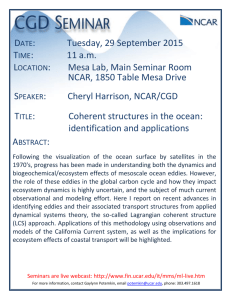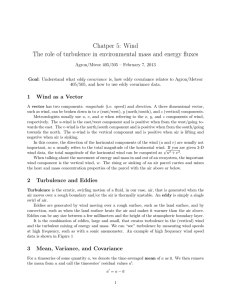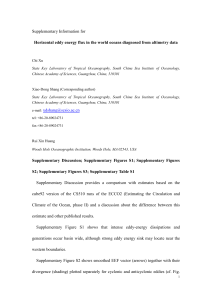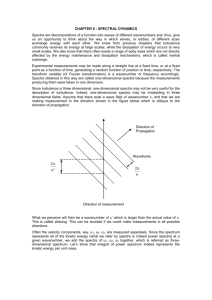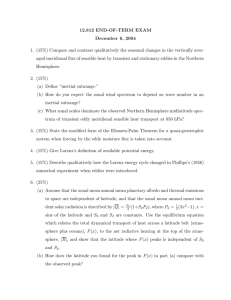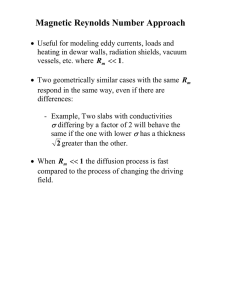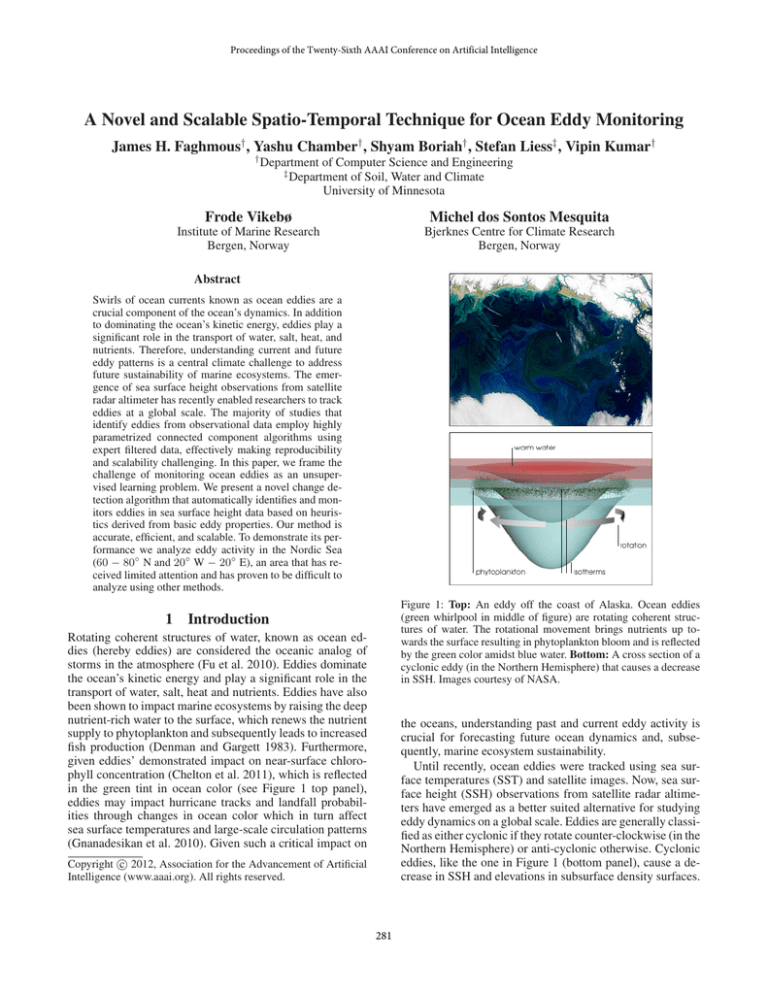
Proceedings of the Twenty-Sixth AAAI Conference on Artificial Intelligence
A Novel and Scalable Spatio-Temporal Technique for Ocean Eddy Monitoring
James H. Faghmous† , Yashu Chamber† , Shyam Boriah† , Stefan Liess‡ , Vipin Kumar†
†
Department of Computer Science and Engineering
‡
Department of Soil, Water and Climate
University of Minnesota
Frode Vikebø
Michel dos Sontos Mesquita
Institute of Marine Research
Bergen, Norway
Bjerknes Centre for Climate Research
Bergen, Norway
Abstract
Swirls of ocean currents known as ocean eddies are a
crucial component of the ocean’s dynamics. In addition
to dominating the ocean’s kinetic energy, eddies play a
significant role in the transport of water, salt, heat, and
nutrients. Therefore, understanding current and future
eddy patterns is a central climate challenge to address
future sustainability of marine ecosystems. The emergence of sea surface height observations from satellite
radar altimeter has recently enabled researchers to track
eddies at a global scale. The majority of studies that
identify eddies from observational data employ highly
parametrized connected component algorithms using
expert filtered data, effectively making reproducibility
and scalability challenging. In this paper, we frame the
challenge of monitoring ocean eddies as an unsupervised learning problem. We present a novel change detection algorithm that automatically identifies and monitors eddies in sea surface height data based on heuristics derived from basic eddy properties. Our method is
accurate, efficient, and scalable. To demonstrate its performance we analyze eddy activity in the Nordic Sea
(60 − 80◦ N and 20◦ W − 20◦ E), an area that has received limited attention and has proven to be difficult to
analyze using other methods.
1
Figure 1: Top: An eddy off the coast of Alaska. Ocean eddies
(green whirlpool in middle of figure) are rotating coherent structures of water. The rotational movement brings nutrients up towards the surface resulting in phytoplankton bloom and is reflected
by the green color amidst blue water. Bottom: A cross section of a
cyclonic eddy (in the Northern Hemisphere) that causes a decrease
in SSH. Images courtesy of NASA.
Introduction
Rotating coherent structures of water, known as ocean eddies (hereby eddies) are considered the oceanic analog of
storms in the atmosphere (Fu et al. 2010). Eddies dominate
the ocean’s kinetic energy and play a significant role in the
transport of water, salt, heat and nutrients. Eddies have also
been shown to impact marine ecosystems by raising the deep
nutrient-rich water to the surface, which renews the nutrient
supply to phytoplankton and subsequently leads to increased
fish production (Denman and Gargett 1983). Furthermore,
given eddies’ demonstrated impact on near-surface chlorophyll concentration (Chelton et al. 2011), which is reflected
in the green tint in ocean color (see Figure 1 top panel),
eddies may impact hurricane tracks and landfall probabilities through changes in ocean color which in turn affect
sea surface temperatures and large-scale circulation patterns
(Gnanadesikan et al. 2010). Given such a critical impact on
the oceans, understanding past and current eddy activity is
crucial for forecasting future ocean dynamics and, subsequently, marine ecosystem sustainability.
Until recently, ocean eddies were tracked using sea surface temperatures (SST) and satellite images. Now, sea surface height (SSH) observations from satellite radar altimeters have emerged as a better suited alternative for studying
eddy dynamics on a global scale. Eddies are generally classified as either cyclonic if they rotate counter-clockwise (in the
Northern Hemisphere) or anti-cyclonic otherwise. Cyclonic
eddies, like the one in Figure 1 (bottom panel), cause a decrease in SSH and elevations in subsurface density surfaces.
c 2012, Association for the Advancement of Artificial
Copyright Intelligence (www.aaai.org). All rights reserved.
281
Figure 3: Global sea surface height (SSH) anomaly for the week
of May 5 1993 from the AVISO dataset. Eddies can be observed
globally as closed contoured negative (dark blue; for cyclonic) or
positive (dark red; for anti-cyclonic) anomalies.
Figure 2: Density surfaces are lifted within a cyclonic eddy causing
a decrease in SSH. The elevation of subsurface density surfaces
replenishes the upper part of the ocean with nutrients needed for
primary production.
nected component algorithm that is similar to the one used
by CH11. We conclude the paper with a discussion of the
study’s contributions and future research directions.
Anti-cyclonic eddies, such as the one depicted in Figure 2,
cause an increase in SSH and depressions in subsurface density surfaces. These characteristics allow us to identify ocean
eddies in SSH satellite data. In Figure 3, anti-cyclonic eddies
can be seen in patches of positive (dark red) SSH anomalies,
while cyclonic eddies are reflected in closed contoured negative (dark blue) SSH anomalies.
The majority of algorithms tracking eddies employ an image processing approach on satellite snapshots of SST or
SSH. Image-based approaches often have computational and
application-specific limitations (that we will discuss in more
detail later). Furthermore, such algorithms are highly parameterized and rely on complex data-filtering schemes that
make reproducibility challenging. We present an unsupervised algorithm that identifies and monitors eddies by analyzing changes in SSH anomaly time-series. This novel approach does not require any data pre-processing and proves
to be more scalable and efficient than traditional tracking
algorithms. To illustrate our algorithm’s performance, we
will focus on monitoring eddies in the Nordic Sea (60 −
80◦ N and 20◦ W − 20◦ E): a region that has received
limited anecdotal attention (e.g. (Hansen, Kvaleberg, and
Samuelsen 2010)). Another advantage of using this region
for evaluation is that it does not suffer from the potential
of confusing Rossby waves (large-scale ocean variability
known as the “internal weather of the sea”) with ocean eddies, a problem that until recently was very common at lower
latitudes (Chelton et al. 2011).
Designing intelligent, reproducible and scalable algorithms is crucial for high impact research in oceanography and related fields, and this work is a first step in that
direction. In the next section, we will briefly review existing eddy tracking algorithms. In the following section,
we will introduce our change detection algorithm, persistent delta (PDELTA), which leverages the unique spatiotemporal characteristic of ocean eddies. After that, we will
present our results and compare them to the eddies identified
by Chelton, Schlax, and Samelson (2011) (CH11 thereafter).
We will also compare PDELTA’s scalability to that of a con-
2
Previous Work
Techniques for automatic identification and tracking of
ocean eddies are largely based on image processing algorithms. Such approaches rely primarily on proxy variables
such as ocean color or SST. The main challenge when using
such proxies to track eddies is that they are influenced by
a variety of factors, including eddies. Thus it is difficult to
link changes in those variables to eddy activity alone. SSH,
however, is a variable that is closely related to the velocity
and scales of eddies and thus is better suited for studies investigating eddy dynamics.
Some of the earliest works based on image processing
techniques used an edge detection algorithm to detect eddies along the Gulf Stream (Holyer and Peckinpaugh 1989).
Similar image-based algorithms included a neural-network
model trained to identify eddies from SST images (Castellani 2006) and an edge detection scheme to isolate eddies
between two consecutive SST images (Fernandes and Nascimento 2006). D’Alimonte (2009) used the isothermal lines
of the SST field to automatically detect eddies. Finally, Dong
et al. (2011) transformed SST observations into a thermalwind-velocity field and subsequently tracked eddies in the
transformed space.
The recent introduction of SSH satellite observations provided researchers with data that are directly related to ocean
eddies. The majority of eddy tracking algorithms define eddies as closed contoured (positive or negative) SSH anomalies (see Figure 3). The first of such studies built upon
techniques developed previously for turbulence simulations
(Isern-Fontanet, Garcı́a-Ladona, and Font 2003). Since then,
numerous variations of the approach used by Isern-Fontanet,
Garcı́a-Ladona, and Font (2003) were introduced, e.g. (Fang
and Morrow 2003; Chaigneau, Gizolme, and Grados 2008).
In the most comprehensive SSH-based eddy tracking study
to date, CH11 identified eddies globally as closed contoured
smoothed SSH anomalies using a nearest neighbor search.
282
Figure 4: A sample time-series analyzed by PDELTA with gradually decreasing segments enclosed between each pair of green and red lines.
These segments were obtained after discarding segments of very short length or insignificant drop that are atypical signatures of an eddy.
They also introduced the notion of eddy non-linearity to differentiate between eddies and Rossby waves. A more detailed review of SSH-based eddy detection methods can be
found in Appendix B of CH11.
Despite a large body of work, eddy detection algorithms
continue to suffer from several limitations. First, watersurface property signatures such as surface temperature or
color do not convey much information on the dynamic
process of eddies (Fu et al. 2010). Second, certain SSHbased methods such as those introduced by Chaigneau,
Gizolme, and Grados (2008) use derivatives of the SSH
field, which amplify the noise in the SSH signal (Chelton,
Schlax, and Samelson 2011). Connected component algorithms, such as CH11, tend to be highly parameterized and
apply scale-dependent filters to the data to remove features
larger (smaller) than a threshold as well as to remove seasonal and internal variability (see Appendix A in CH11 or
online supplementary material of (Chelton et al. 2011) for
full details on data filtering.) Finally, for each pixel in an
SSH snapshot (such as Figure 3), connected component algorithms must search N -nearest neighbors for each pixel
making the search space very large as data resolution is increased (see complexity analysis section for details).
3
Figure 5: An illustration to show PDELTA’s spatial analysis component. At any given time ti only a subset of all time-series are labeled as candidates for being part of an eddy (green points). Only
when a sufficient number of similarly behaving neighbors are detected (in this case four) PDELTA labels them as an eddy (black
circle). As time passes, some time-series are removed from the
eddy (red points) as they are no longer exhibiting a gradual change;
while others are added. If the number of similarly behaving timeseries falls below (above) the minimum (maximum) number of required time-series, the cluster is no longer an eddy (e.g. top left
corner at ti+2 frame).
eddy must operate over a large enough region, for each time
step t we scan the neighbors of any candidate time-series
(where ts ≤ t ≤ te ); if a sufficient number of neighbors are
also candidate time-series at time t then the identified group
is labeled as an eddy. Finally, as the eddy moves from one
time-step to the next, we keep adding new candidate timeseries as their ts is reached and remove other time-series as
their te is passed. We count the duration of each eddy as the
number of weeks the minimum number of clustered candidate time-series is met.
Our approach differs from the original PDELTA described
in (Chamber et al. 2011) in two main aspects: first, Chamber
et al. (2011) used PDELTA as a time-series change algorithm
only. In our case, we augment PDELTA by adding a spatial
analysis feature to properly identify clusters of time-series
exhibiting similar behavior. Second, the original PDELTA
only detected a single increasing (decreasing) segment in a
given time-series. In this variation, PDELTA identifies multiple gradually changing segments within a time-series. This
is a useful improvement given that an eddy may appear multiple times at the same location. Furthermore, this feature effectively improves our computational performance by mon-
Methods
Instead of tracking eddies directly in images of SSH anomalies (such as in Figure 3), we propose a novel approach that
leverages the fundamental spatio-temporal characteristics of
eddies. Eddies form and sustain their energy over a timescale
of weeks to months, resulting in gradual changes in SSH
on the order of a few centimeters over regions between 50200 kilometers. Given the large time-scales within which eddies operate, eddies will manifest as a connected group of
gradually increasing/decreasing SSH time-series. We leverage this information to track eddies directly from the SSH
time-series (see Figure 4) as opposed to the SSH heat-maps.
Our algorithm (adapted from (Chamber et al. 2011)) operates in three main steps, first we identify individual timeseries that have the previously described “eddy-like” behavior. Each candidate time-series will be labeled with a start
and end time (ts and te respectively) where a significant
gradual increase/decrease occurred. Second, given that an
283
Figure 6: Monthly eddy counts (lifetime ≥ 16 weeks). Top: Monthly counts for cyclonic eddies as detected by our automated algorithm
PDELTA (blue) and CH11 (red). Bottom: Monthly counts for anti-cyclonic eddies as detected by our automated algorithm PDELTA (blue)
and CH11 (red). Overall, PDELTA detected slightly more eddies than CH11. This could be due to an improved ability to track smaller eddies
(see text).
itoring each location (time-series) at most once. For a complete discussion of the original PDELTA algorithm, including experiments, please refer to (Chamber et al. 2011).
Figure 4 demonstrates how our approach detects candidate time-series. The figure shows the SSH anomaly timeseries for one grid point in the Nordic Sea. For this particular
location, PDELTA identified three segments where a significant gradual decrease in SSH occurred over a long time period starting at approximatively weeks 60, 410, and 870 respectively. During each decreasing segment, we search this
location’s neighborhood for time-series with similar gradual
decrease. Once the significant decreasing segment ends, either there will be other neighbors that will continue to form
a coherent eddy or the eddy has dissipated if the minimum
eddy size is no longer met (see Figure 5).
A spatio-temporal approach to eddy detection and monitoring has several advantages: First, we don’t apply any
filters to our data and have a minimal number of parameters relative to existing approaches. Second, given that we
only consider time-series that experience gradual changes in
SSH, our algorithm’s search space is significantly reduced
compared to searching every pixel’s neighbors. Finally,
since we incorporate a spatio-temporal detection mechanism we can relax some of the minimum/maximum eddy
size requirements that space-only connected component algorithms have.
4
Figure 7: Eddy geographic distribution density. The eddies
PDELTA identified (left) were similarly distributed as CH11
(right), except for higher latitudes where PDELTA successfully
identified a region known for spawning high latitude eddies
(Rossby, Prater, and Søiland 2009) (see Figure 8). Landmasses are
colored in dark green.
results with those of CH111 . We used the Version 3 dataset
of the Archiving, Validation, and Interpretation of Satellite
Oceanographic (AVISO) which contains 7-day averages of
SSH on a 0.25◦ grid from October 1992 through January
2011.
PDELTA detected slightly more cyclonic (9.89 per
month) than anti-cyclonic (9.48 per month) eddies. These
differences are consistent with the findings of CH11. Overall, we identified a total of 9.08 eddies per month versus
8.87 for CH11. This could be due to the fact that eddies
Results
1
Available from: http://cioss.coas.oregonstate.edu/eddies/nc
data.html
We tracked eddies weekly from 1992-2011 in the Nordic Sea
region (60 − 80◦ N and 20◦ W − 20◦ E) and compared the
284
tend to be smaller in the region analyzed, and thus could
have been ignored by CH11’s algorithm once the data were
filtered. Figure 6 shows the monthly cyclonic (top) and
anti-cyclonic (bottom) counts for PDELTA (blue curve) and
CH11 (red curve). We find that although the counts match
well, PDELTA detected fewer eddies than CH11 during winter months, but more eddies during summer months. This
may be due to the gaps in satellite data during winter or simply due to seasonality (i.e. fewer eddies in winter time).
To visualize PDELTA’s performance compared to CH11,
we computed the eddy distribution density based on the locations where eddies were detected. We first divided the
Nordic Sea region into 1◦ cells and counted the total number of eddies passing through each cell. The spatial distribution densities are shown in Figure 7. Both algorithms detect eddies in “active regions” such as near the Norwegian
coast. PDELTA, however, finds more eddies than CH11 in
higher latitudes possibly because without data filtering we
do not wipeout small-scale eddies. The mean radius of eddies decrease approximately monotonically from about 200
km near the equator to about 75 km at 60◦ latitude (Chelton
et al. 2007; Fu et al. 2010), giving our algorithm an advantage to detect such eddies.
climate datasets. Therefore, for our algorithm to have real
world value, it must scale up to the demands of the climate
research community.
To test our algorithm’s performance on the potential increase in both data resolution and timespan we compared
our algorithm’s performance to a connected component eddy
searching algorithm similar to the one described in Appendix B of CH11. We constructed two datasets from the
original data, one where the data’s resolution increased up
to 100 times (10 times in each grid dimension) and a second where the length of the time-series increased up to 100
times. We then tracked eddies at weekly intervals for the entire period covered by the data.
Computational Complexity. For a grid with M × N observations and time-series length K, the time complexity
of PDELTA is linear in the number of grid cells, and the
time-series length (i.e. O(M N K)). On the other hand, connected component algorithms are quadratic in the number of
grid cells, (i.e. O((M N )2 K)). The space requirements of
both approaches are modest. Figure 9 shows empirical results comparing the computation time of PDELTA and the
connected component algorithm as the number of grid cells
(M ×N ) and time-series length (K) are increased; the figure
shows quadratic increase in computation time for the connected component algorithm as M × N is increased, while
PDELTA’s computation time increases linearly. This difference is particularly germane since data from future climate
models and satellite observations will be of much higher
resolution (M × N is expected to increase by orders of
magnitude) than today’s datasets and will approach 100s of
petabytes (Overpeck et al. 2011).
5
Discussion & Future Work
We presented an automated, accurate, and scalable eddy detection and monitoring algorithm based on gradual changes
in SSH time-series. While unique, our approach currently
suffers from several limitations: First, our minimum and
maximum eddy size criteria are hard-coded parameters.
Given that we do not filter our data, large-scale phenomena
such as gyres and currents are still present in the data and
can be mistaken for very large eddies. Conversely, although
we are able to detect smaller eddies than CH11, we must
ensure that a sufficient number of neighboring time-series
experience similar gradual change. To address this issue we
imposed a user-specified minimum and maximum eddy size.
Future iterations of the algorithm would benefit from automatic parameter estimation that adapts minimum and maximum eddy size based on latitude, since eddy sizes vary as a
function of latitude (Fu et al. 2010). Another potential investigation could be a sensitivity study of our algorithm’s performance to the space and time thresholds mentioned above.
Second, our algorithm does not account for gaps in the
data and simply ignores missing values. That is why certain weeks will have very low eddy counts, especially during
winter, when precipitation obstructs satellite visibility. Previous works have addressed this challenge by using extrapolation to fill in missing data (Chelton et al. 2011). Although
Figure 8: Path of the Gulf Stream (red band) from the tropics
to the Arctic. The northern eddies that our PDELTA algorithm
identifies in Figure 7 (big gray arrow) is near the region where
the Gulf Stream splits generating high latitude eddies that CH11
failed to capture. The existence of such eddies confirmed by field
experiments (Rossby, Prater, and Søiland 2009). Figure source:
http://en.wikipedia.org/wiki/Gulf Stream
As shown in Figure 8, the northern region captured by
PDELTA and not by CH11 (see Figure 7) is where the Gulf
Stream splits into the North Cape Current (right split) and
the West Spitsbergena (left split) (AMAP 1998). Though
different conditions may trigger eddies, they are frequently
observed in relation to meandering flows in strong ocean
currents (like the Gulf stream (Chelton, Schlax, and Samelson 2011)). Moreover, the region we identified has been
specifically monitored using buoyant floats and was found
to have noticeable eddy activity (Rossby, Prater, and Søiland
2009). This is further indication that PDELTA is better able
to track small eddies.
Although our algorithm has proven capable of monitoring eddies, the increasing size and resolution of climate
data make it imperative that algorithms be scalable for large
285
Figure 9: Scalability comparison between our algorithm PDELTA (blue) and a connected component algorithm (green) similar to CH11.
Left: time required to track all eddies in the dataset as a function of the grid resolution. Right: time required to track all eddies in the dataset
as a function of the time-series length (i.e. number of weekly observations). Our algorithm PDELTA (blue) scales better than the connected
component algorithm in both time and space.
our algorithm can take advantage of extrapolation, such an
approach is not ideal since the factors that impact most climate data such as SSH are highly non-linear, whereas existing extrapolation techniques are not and, therefore, cannot capture such influences. Such a limitation significantly
decreases the reliability of data extrapolation. Instead, we
would propose to use time-series interpolation algorithms,
which have recently been studied in the context of seasonal
earth science data (Hird and McDermid 2009) as well as established matrix completion techniques (Candès and Recht
2009).
Third, previous studies investigating eddy dynamics have
mistaken eddies with Rossby waves (large-scale ocean variability that masquerades as an eddy). Because we analyze
global data, and given that we do not filter the data beforehand, there is an increased likelihood of false-positives.
To address this issue, CH11 used the eddies’ nonlinearity
(the ratio of an eddy’s rotational and transitional speeds)
as a mechanism to differentiate between eddies and Rossby
waves. In future work, we will add this type of discriminant
to eliminate Rossby waves from our analysis. It is important
to note that this issue does not impact our current analysis
given that Rossby waves are easily discernible from ocean
eddies at high latitudes (Fu et al. 2010).
Finally, although we report similar monthly eddy counts
and spatial distribution as CH11, we must caution that analyzing eddy count alone is an incomplete comparison to
CH11. Additional eddy statistics and kinematic properties
such as eddy size and speed must be analyzed to fully compare PDELTA to CH11.
Despite these limitations, our algorithm produces similar counts to the state-of-the-art eddy tracking algorithms by
leveraging the natural spatio-temporal characteristics of eddies. Additionally, it is capable of identifying regions that
other algorithms cannot and these regions have been corroborated by field studies (Rossby, Prater, and Søiland 2009).
Identifying small eddies (< 100km) has been challenging
for connected component techniques given current data resolution and filtering techniques. By monitoring SSH patterns
through changes in the time-series as opposed to visual images, we are able to capture smaller eddies than possible
with the existing approaches. Finally, as opposed to common connected component algorithms that run quadratically
in the grid resolution, PDELTA runs in linear time – a significant improvement given the expected dramatic increase
in climate data (Overpeck et al. 2011).
We foresee our algorithm being used in other domains
where one is interested in automatically monitoring gradual changes in time-series data. A recent paper by Giles et
al. (2012) monitored the western Arctic Beaufort Gyre using SSH from satellite data. Automatic gyre monitoring can
also be an application to our algorithm. While this line of
research is critical to understanding future ocean dynamics
and marine ecosystems, it also has important applications to
time-series and matrix completion, scalable learning algorithms, and spatio-temporal data mining.
6
Acknowledgments
This work was funded by an NSF Graduate Research Fellowship, an NSF Nordic Research Opportunity Grant, the
Norwegian National Research Council, the Planetary Skin
Institute, NSF Grant IIS-0905581, and an NSF Expeditions
in Computing Grant (#1029711). The authors are grateful
to Dudley Chelton for helpful comments that improved the
clarity of the manuscript. Access to computing resources
was provided by the University of Minnesota Supercomputing Institute.
286
7
Appendix
Chelton, D.; Schlax, M.; and Samelson, R. 2011. Global
observations of nonlinear mesoscale eddies. Progress in
Oceanography.
D’Alimonte, D. 2009. Detection of mesoscale eddy-related
structures through iso-sst patterns. Geoscience and Remote
Sensing Letters, IEEE 6(2):189–193.
Denman, K., and Gargett, A. 1983. Time and space scales of
vertical mixing and advection of phytoplankton in the upper
ocean. Limnology and Oceanography 801–815.
Dong, C.; Nencioli, F.; Liu, Y.; and McWilliams, J. 2011. An
automated approach to detect oceanic eddies from satellite
remotely sensed sea surface temperature data. Geoscience
and Remote Sensing Letters, IEEE (99):1–5.
Fang, F., and Morrow, R. 2003. Evolution, movement
and decay of warm-core leeuwin current eddies. Deep Sea
Research Part II: Topical Studies in Oceanography 50(1213):2245–2261.
Fernandes, A., and Nascimento, S. 2006. Automatic water eddy detection in sst maps using random ellipse fitting
and vectorial fields for image segmentation. In Discovery
Science, 77–88. Springer.
Fu, L.; Chelton, D.; Le Traon, P.; and Morrow, R. 2010.
Eddy dynamics from satellite altimetry. Oceanography
23(4):14–25.
Giles, K. A.; Laxon, S. W.; Ridout, A. L.; Wingham, D. J.;
and Bacon, S. 2012. Western arctic ocean freshwater storage increased by wind-driven spin-up of the beaufort gyre.
Nature Geosci advance online publication:–.
Gnanadesikan, A.; Emanuel, K.; Vecchi, G.; Anderson, W.;
Hallberg, R.; et al. 2010. How ocean color can steer pacific
tropical cyclones. Geophysical Research Letters.
Hansen, C.; Kvaleberg, E.; and Samuelsen, A. 2010. Anticyclonic eddies in the norwegian sea; their generation, evolution and impact on primary production. Deep Sea Research
Part I: Oceanographic Research Papers 57(9):1079–1091.
Hird, J., and McDermid, G. 2009. Noise reduction of
ndvi time-series: An empirical comparison of selected techniques. Remote Sensing of Environment 113(1):248 – 258.
Holyer, R., and Peckinpaugh, S. 1989. Edge detection applied to satellite imagery of the oceans. Geoscience and
Remote Sensing, IEEE Transactions on 27(1):46–56.
Isern-Fontanet, J.; Garcı́a-Ladona, E.; and Font, J. 2003.
Identification of marine eddies from altimetric maps. Journal of Atmospheric and Oceanic Technology 20(5):772–778.
Overpeck, J.; Meehl, G.; Bony, S.; and Easterling, D.
2011. Climate data challenges in the 21st century. Science
331(6018):700.
Rossby, T.; Prater, M.; and Søiland, H. 2009. Pathways
of inflow and dispersion of warm waters in the nordic seas.
Journal of Geophysical Research 114(C4):C04011.
The pseudo-code for PDELTA is listed in Algorithm 1. α and
β are the start and end time steps for a decreasing segment,
and subscript j tracks the number of such segments. Ł is the
loss (or gain) in height due to the decrease (increase).
Algorithm 1 PDELTA algorithm for gradual decrease detection.
n = number of time steps in the time-series T
S = season length
v = v1 , v2 , ..., vn (time-series values)
for t = S → n − S do
∆t ← mean(vt−S+1 · · · vt ) − mean(vt+1 · · · vt+S )
end for
j←0
t←S
while t ≤ n − S do
if ∆t > 0 then
j ←j+1
αj ← t
while ∆t > 0 do
t←t+1
end while
βj ← t
βj
P
∆t
t=αj
Łj ←
end if
t←t+1
end while
S
References
AMAP, A. 1998. assessment report: Arctic pollution issues.
Arctic Monitoring and Assessment Programme (AMAP),
Oslo, Norway 12:859.
Candès, E., and Recht, B. 2009. Exact matrix completion via
convex optimization. Foundations of Computational Mathematics 9(6):717–772.
Castellani, M. 2006. Identification of eddies from sea surface temperature maps with neural networks. International
journal of remote sensing 27(8):1601–1618.
Chaigneau, A.; Gizolme, A.; and Grados, C.
2008.
Mesoscale eddies off peru in altimeter records: Identification algorithms and eddy spatio-temporal patterns. Progress
in Oceanography 79(2-4):106–119.
Chamber, Y.; Garg, A.; Mithal, V.; Brugere, I.; Lau, M.; Krishna, V.; Boriah, S.; Steinbach, M.; Kumar, V.; Potter, C.;
and Klooster, S. A. 2011. A novel time series based approach to detect gradual vegetation changes in forests. In
CIDU 2011: Proceedings of the NASA Conference on Intelligent Data Understanding, 248–262.
Chelton, D.; Schlax, M.; Samelson, R.; and de Szoeke, R.
2007. Global observations of large oceanic eddies. Geophysical Research Letters 34:L15606.
Chelton, D.; Gaube, P.; Schlax, M.; Early, J.; and Samelson,
R. 2011. The influence of nonlinear mesoscale eddies on
near-surface oceanic chlorophyll. Science 334(6054):328–
332.
287

